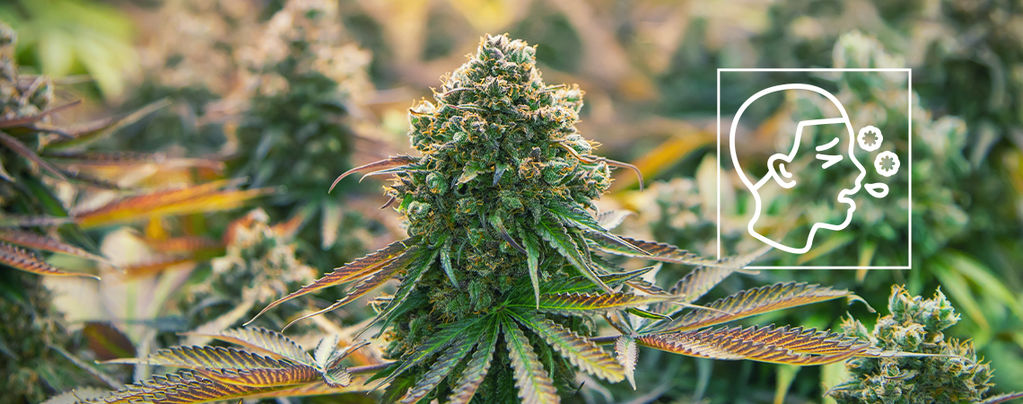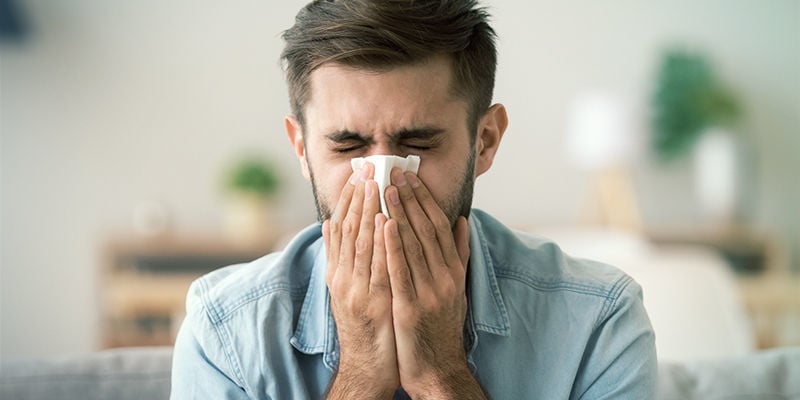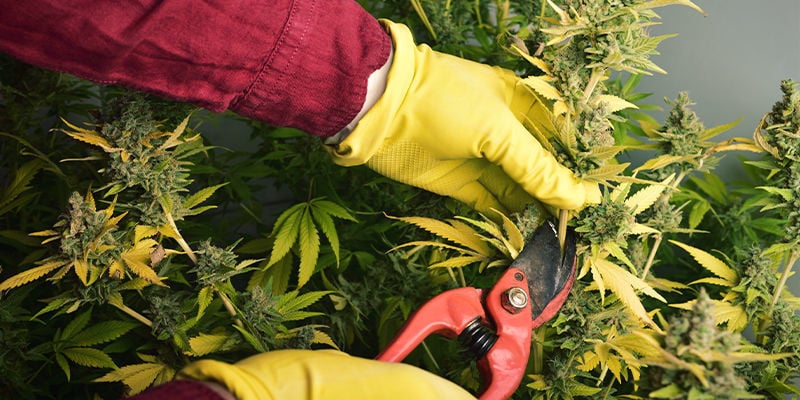
What Are Cannabis Allergies?
Although extremely rare, cannabis allergies do exist and can cause mild to more severe symptoms in some instances. But is it actually down to the plant itself, or do pollen, mould, and pests play more of a role than we think? We uncover everything you need to know about cannabis allergies and how they can impact your enjoyment of your herb.
We're all no doubt familiar with more common allergies such as reactions to certain foods, medications, mould and even dust, but is it possible to be allergic to cannabis? You might be surprised to learn that weed can potentially elicit an allergic reaction in humans. But don't worry; we delve into the sign, symptoms and science behind cannabis allergies. We also drop some hints and tips on how it's possible to manage it to stop it from impeding your overall enjoyment of your favourite herb.
Can you be allergic to cannabis?

We've hinted at the answer already, but yes, much like other exposure to other plants and pollen, it's entirely possible to be allergic to cannabis. While it may manifest itself in plenty of different ways, it only impacts a very small number of people. However, it's worth noting that cannabinoids are not responsible for causing allergies. In fact, it's other areas of the plant that produce allergic reactions, such as the pollen produced and the presence of pests and mould.
What is a cannabis allergy?
While cannabis allergies only affect an extremely small percentage of people, the impact can range from mild to severe. However, it's essentially just a reaction from your body's immune system, protecting you from what it perceives as a threat. The allergy can manifest itself in a variety of different ways, from sneezing to itchy eyes to even nausea; there's no uniform way a person's body can react. Sometimes the allergy itself isn't down to the plant, pollen or pests per se, as plants or seeds from less reputable sources can contain pesticides and other chemicals, all of which can cause issues. Exposure to mould from a plant that has not been maintained can also be responsible for an allergic reaction. So when we talk about a cannabis allergy, other factors can more often than not play into it.
Cannabis allergy symptoms

So what signs should you be on the lookout for if you suspect that you might have an allergy to cannabis? While smoking cannabis can cause bloodshot eyes, this isn't seen as an allergic reaction but is an increase of blood flow to the eye. So if you were thinking this was a symptom of an allergy you've been experiencing, rest assured that it's just part of the smoking ritual for many. We've put together the following list of potential symptoms you might see from exposure to cannabis plants.
Itching
Itchy patches of skin may be an allergic reaction for some. Coming into contact with pollen or mould can cause itching in a person. Although not severe, it will almost certainly be uncomfortable.
Redness
Coupled with itchiness, redness can also develop. This can be anywhere on the body. Some may experience redness around their eyes after being exposed to pollen or mould, or simply redness around an area that has been itchy.
Dry skin
Dry skin is also a symptom of an allergic reaction. This can happen after handling cannabis and being exposed to pollen or potential mould. Dry skin can occur almost immediately after exposure, but many will see symptoms after an hour or so.
Rash
Similar to that of dry skin and redness, a rash is another possible symptom of cannabis allergies.
Nausea
Inhalation of cannabis pollen or mould can cause symptoms of nausea that can make a person feel unwell. While this nausea isn't long-lasting, those impacted will certainly feel unwell for some time.
Watery eyes
Inhalation of cannabis pollen can bring on similar effects to that of hay fever. One such symptom is watery eyes. While a pretty mild symptom, it can lead to further irritation and redness.
Sore throat/coughing
A common symptom, coughing, and a subsequent sore throat is quite common for those suffering from an allergic reaction to cannabis.
Nasal congestion/sneezing
Similar to hay fever, a blocked nose, sneezing and other cold-like symptoms are very common for cannabis allergies.
Anaphylaxis
Those suffering from the most extreme form of an allergic reaction can experience anaphylaxis. This is a life-threatening condition that can cause more severe effects such as fainting, low blood pressure and difficulty breathing. In this case, it's best to seek immediate medical attention should this occur.
As mentioned, the severity of effects can vary greatly. Those impacted may feel very mild symptoms, or some may find them to be quite severe. But thankfully, they are also extremely rare.
What causes an allergic reaction to cannabis?

Allergic reactions to cannabis can be caused by handling the plant, inhaling the pollen, smoking or eating cannabis. Arguably the most common allergic reaction is exposure to pollen, mould or pests on a plant. However, as these are found in most plants, those already suffering from allergies for dust mites, plants or mould may already have the predisposition to be impacted by the cannabis plant, as they will likely be more susceptible.
That's not to say that those without prior allergies aren't able to develop symptoms. Evidence suggests that professional growers in the cannabis industry that handle and are exposed to large quantities of plant matter can potentially have an allergic reaction. This is caused by exposure to the pollen, mould and mildew spreading out from the flowering plants. This has even led to physicians encouraging growers to protect their skin and their respiratory airways when working with cannabis plants to lower the risk of allergic reactions.
Reports of cannabis allergies have certainly seen their fair share of exposure in recent times, thanks to decriminalisation, legalisation and more mainstream practices being conducted in different countries. While those with constant exposure to plants in professional growing setups are the ones most likely to naturally develop symptoms of allergies, this has not stopped mainstream media from sensationally reporting cannabis allergies to be a much more widespread problem. As arguably more people today than ever have access to cannabis, more reports of related allergies are available to the public as a by-product. However, cannabis has been around for many thousands of years and hasn't all of a sudden evolved to produce allergic reactions in users.
Diagnosing a cannabis allergy

So now we know what cannabis allergies are and the related symptoms; how do you diagnose an allergy? Two different tests can be carried out to show if a person is more susceptible to an allergic reaction. This is through a skin or blood test.
Skin test
A skin test is the most common testing method for allergies and can be carried out by a doctor. The test is straightforward and relies on a person's skin coming into contact with a drop of diluted allergen, such as cannabis or pollen. A small lancet is then used to prick the skin under the drop and afterwards the treated area will be monitored for an adverse reaction (typically an itchy red bump). This is then left for around 15 minutes to ensure that no itchiness, redness or rash appears. If a person does not display any reaction, it's pretty safe to say that they won't have an allergy to cannabis.
Blood test
As a slightly more involved method of checking whether a person is allergic to cannabis, a blood test can be administered to provide a result. This is achieved by taking a blood sample and testing it for antibodies to cannabis. If there are heightened levels of antibodies present in the blood, they'll likely be allergic to cannabis. While this provides an accurate way of testing for allergies, it can also be time-consuming as results can take a while to return from the doctor.
It is also worth noting that the availability of such tests may vary depending on the country you are located in.
How to overcome a cannabis allergy

If you find that you're suffering from an allergic reaction to cannabis, there are a few things you can do to combat and alleviate symptoms. Those suffering from skin-related issues can turn to antihistamines for relief. Mainly used to reduce symptoms in hay fever sufferers, antihistamines can be used to treat rashes, itchiness and redness.
In cases of coughing or nasal congestion, over-the-counter cold and flu medicine can reduce the symptoms significantly, but this shouldn't be relied upon as a long term solution. Of course, if you're having frequent allergic reactions, you can always look to reduce the amount of cannabis you're exposed to or simply consult a doctor and be tested thoroughly for any allergies.
Should you be worried about cannabis allergies?

In short, no, you shouldn't be worried about cannabis allergies. The term itself is really relating to the pollen, pests and mould present in the plant and not from smoking or using cannabis. The reality is if you already have an allergy to a plant, chances are you'll have the same reaction to cannabis or any other kind of flowering plant. If it is something that you're unsure of, you can easily visit a health professional and be tested to see if you have an allergic reaction to cannabis. As discussed, it really is a rare occurrence, and if a reaction is present, it's most likely in its mildest form and won't require any further action.
-
 5 min
13 January 2022
What Are The Side Effects Of THC?
THC-rich cannabis is one of the most popular recreational drugs in the world, as well as one of the most sought-after holistic herbs. And while cannabis is often praised for being natural and...
5 min
13 January 2022
What Are The Side Effects Of THC?
THC-rich cannabis is one of the most popular recreational drugs in the world, as well as one of the most sought-after holistic herbs. And while cannabis is often praised for being natural and...
-
 5 min
8 November 2018
Top 10 Mould-Resistant Cannabis Strains
Avoid the heartbreak of mushy, mouldy buds. Growing these top 10 mould-resistant strains means growing with confidence in humid or damp weather.
5 min
8 November 2018
Top 10 Mould-Resistant Cannabis Strains
Avoid the heartbreak of mushy, mouldy buds. Growing these top 10 mould-resistant strains means growing with confidence in humid or damp weather.
-
 3 min
7 November 2018
Effect Of Cannabis On Your Body
Cannabis has many impacts on the body. Most of them are positive (both short and longer term). However, there are some negative side effects users should be aware of.
3 min
7 November 2018
Effect Of Cannabis On Your Body
Cannabis has many impacts on the body. Most of them are positive (both short and longer term). However, there are some negative side effects users should be aware of.












 United States
United States










